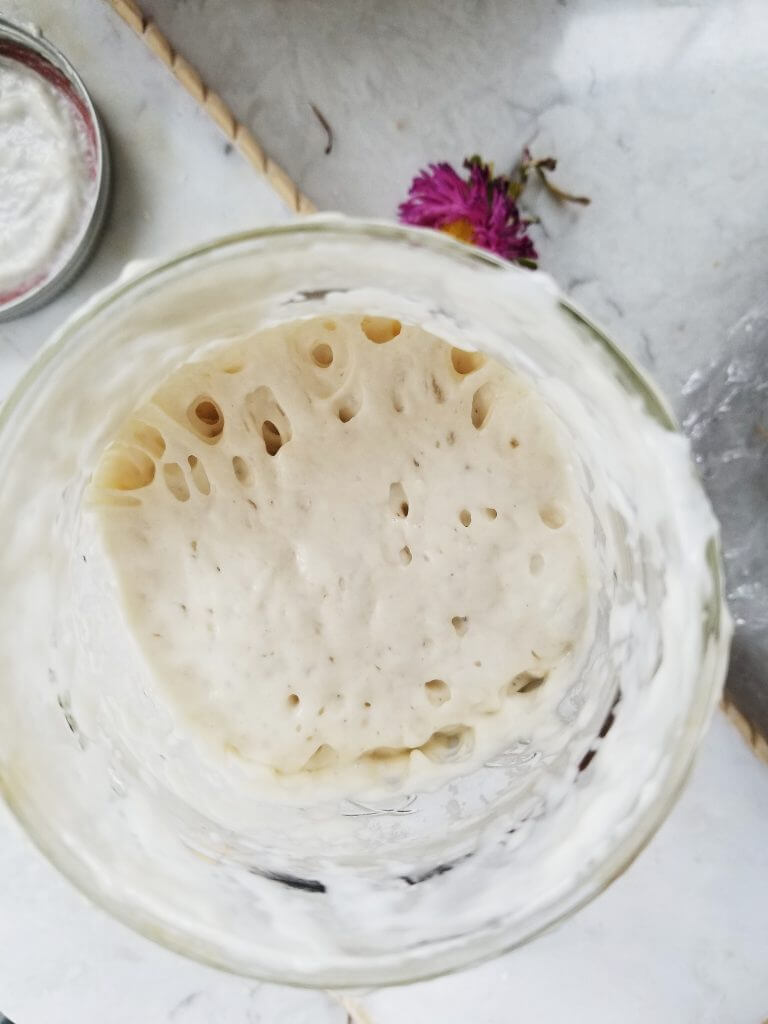
How to make a sourdough starter at home! If you are looking for how to make your very own sourdough starter from scratch you came to the right place! Making a sourdough starter at home is easier than you think!
All you need to make a homemade sourdough starter are a few basic supplies and ingredients, like flour and water, and a couple weeks of waiting. Sourdough is an amazing base in many great bread recipes and will give you a unique flavor from the wild yeast!
Sourdough is ALL over the place right now. You see sourdough bread, sourdough pancakes, and even sourdough cinnamon rolls! But how do you make it??
The first 2 times I tried making it, I ended up with a thick, sludgy and rotten sourdough starter. So, I decided to take some of the lessons I learned when I brewed my own kombucha to try a third time. And third time is a charm because I present this "how to make a sourdough starter" to you!
SOURDOUGH STARTER FOR BEGINNERS
So I know a lot of people weight their sourdough starter for feedings, but I am going to show you how to make a sourdough starter without having to weigh it. We will look at cups and the texture of the starter you should be looking for.
Also- You don't really have to feed your sourdough starter 2x per day. I grew mine in ~13 days and only fed it once a day. It is more about warmth than anything. But, if you want to grow your sourdough starter in a week, twice a day feedings will work better for you!
HOW TO MAKE A SOURDOUGH STARTER WITHOUT YEAST
All you need to make a sourdough starter from scratch with NO yeast is:
- whole wheat flour
- unbleached all purpose flour
- filtered water
TOOLS YOU NEED TO MAKE A STARTERDOUGH STARTER
It is best to grow your sourdough starter in a glass jar, because you don't want any of the yeast interacting with a plastic container and contaminating your starter. Make sure your jar is large enough!
What you need to get your sourdough started:
- 32 ounce glass jar
- Cheesecloth or any breathable cloth to cover
- Rubber band to secure the cloth
TIPS TO MAKE A SOURDOUGH STARTER AT HOME
- START WITH WHOLE WHEAT FLOUR. Whole wheat flour has a diverse colony of good bacteria along with nutrients to get your sourdough started.
- KEEP YOUR SOURDOUGH STARTER IN A WARM PLACE. Cold=mold. Keep your sourdough starter in a warm place while you are growing it! I keep mine either wrapped in a towel on top of the stove, or inside the stove with the oven light on.
- USE UNBLEACHED FLOUR TO FEED. Make sure you feed your sourdough starter with unbleached flour, the bleach can kill the wild yeast in your sourdough.
- USE FILTERED WATER NOT TAP WATER. Certain contaminants in tap water like chlorine can kill yeast and good bacteria in your sourdough starter. Make sure you are feeding your starter with filtered room temperature (not cold & not hot) water.
- LOOK FOR A THICK YOGURT-LIKE TEXTURE AFTER FEEDING. Since I do not weigh my starter, I am looking for a thick Greek-yogurt like texture. If yours is runny after feeding, add a bit more flour. If it is very thick and dough-like, add a little more water.
HOW TO MAKE A SOURDOUGH STARTER FROM SCRATCH
STEP 1: START WITH WHOLE WHEAT FLOUR & WATER
- Add 1 cup of whole wheat flour to the jar.
- Add ½ cup room temperature water.
- Stir well until it forms a ball.
- Scrape down the sides of your jar very well.
- Cover your jar with cheesecloth.
- Secure it with a rubber band.
- Place somewhere warm for about 24-48 hours.
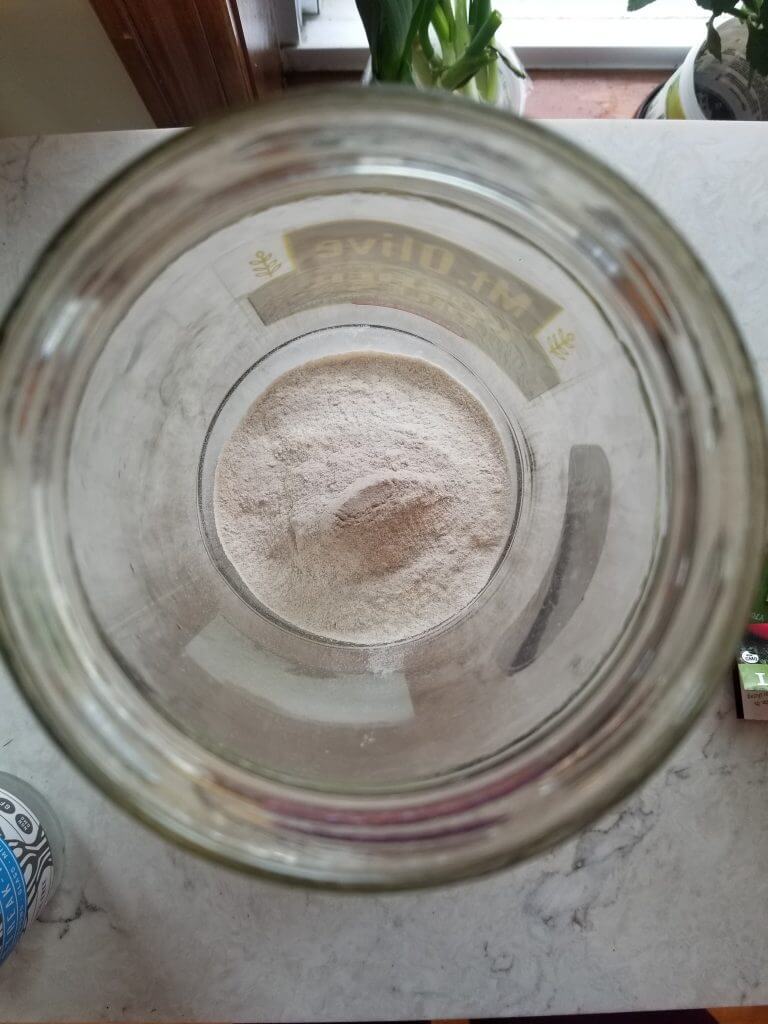

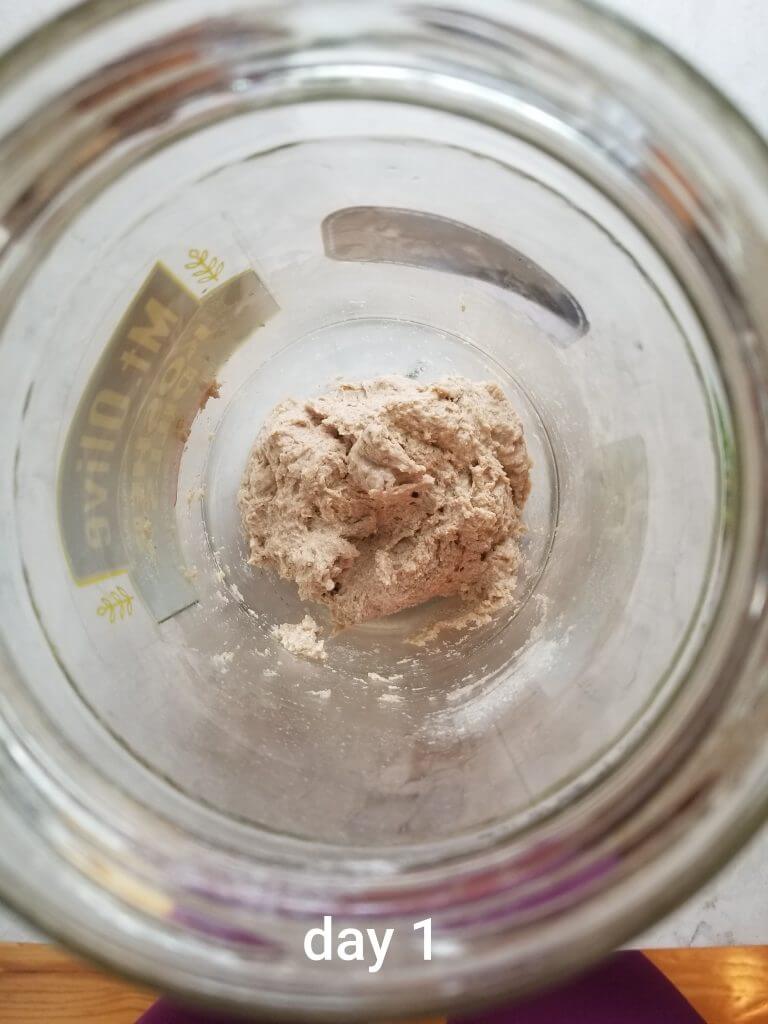
I saw some say to heat the water a bit, and some say to use cool water. But, bacteria like harmony. So too much heat will kill them while too cold will slow them down.
I found that using the filtered water from my water filter that I keep on the counter at room temperature to work really great in my sourdough starter recipe.
A lot of tap water contains heavy metals, fluoride, chlorine, and other contaminants. These contaminants can delay or even kill the good yeast and bacteria in your sourdough starter. Make sure you are using good filtered water.
I see a lot of articles that tell you to use a lid when making a homemade sourdough starter. I have found that this doesn't allow much air to circulate which could cause too much alcohol to build up on top. I'll only use a tight fitting lid after I have a good bubbly sourdough starter and I am transferring it to the fridge.
STEP 2: LOOK FOR ACTIVITY
Depending on how warm your house is, it could take between 24-48 hours to see activity. In those 24-48 hours, when you see a lot of bubbles and the volume is about double:
- Discard half of the wheat flour sourdough mixture
- Add 1 cup unbleached all purpose flour
- Add ½ cup room temperature filtered water
- Stir the flour in completely
- Cover with a cloth
- Place somewhere warm another 24 hours
- Repeat steps 1-6 every morning for 7-14 days.

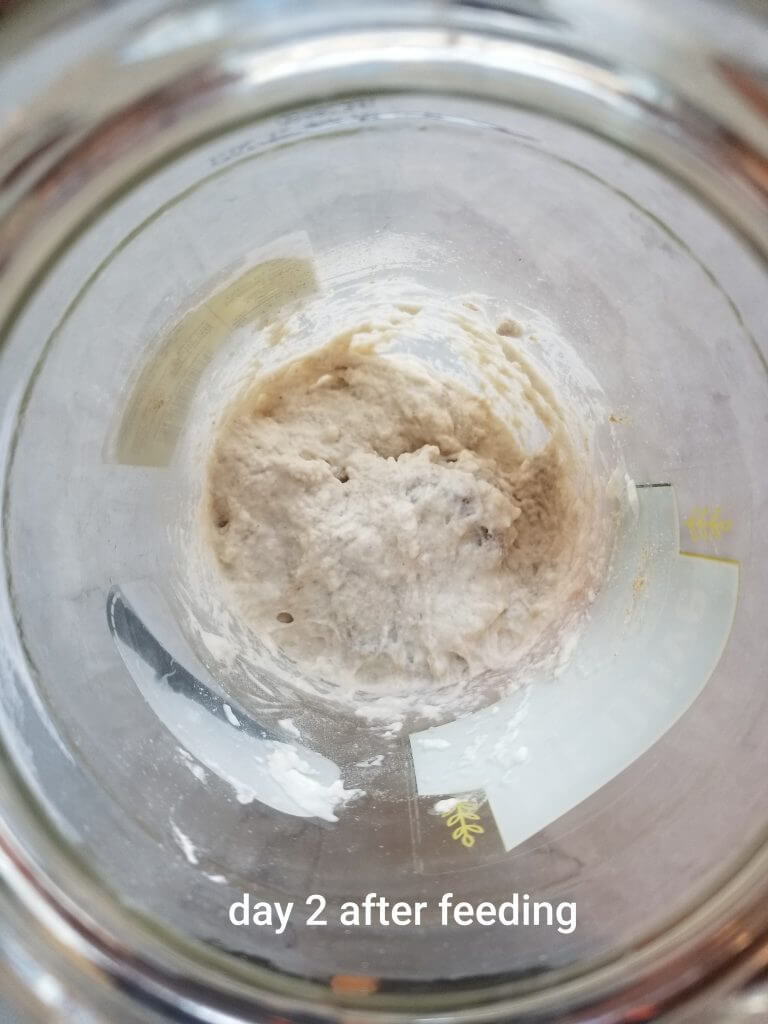
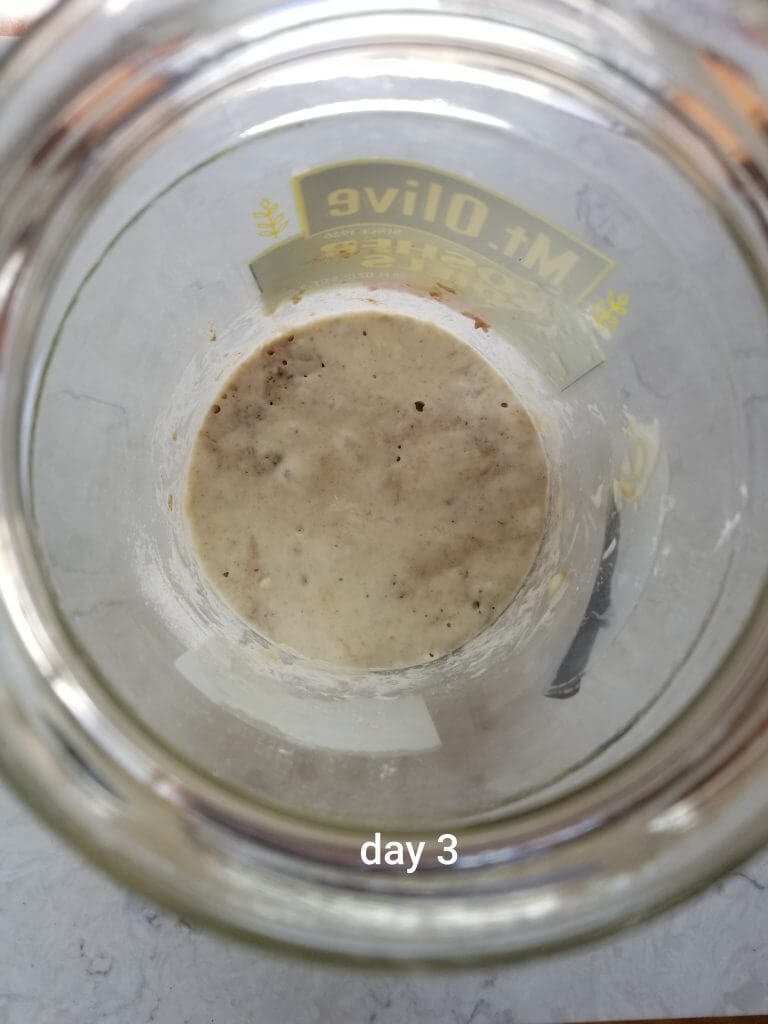
YOUR MORNING SOURDOUGH ROUTINE FOR DAYS 4-14:
- Discard half of the sourdough starter in the jar. You can use this discard to make quick breads, muffins and other yummy treats.
- Add 1 cup UNBLEACHED all-purpose flour
- Add ½ cup room temperature water
- Stir COMPLETELY
- Cover with the cheesecloth
- Store somewhere warm where it gets airflow
Day 6, we are starting to get a lot more bubbles!
Now that you see so many bubbles and activity in your sourdough starter, you can start monitoring how fast it grows after feeding.
Add a rubber band level to where the dough is AFTER you fed it. You should be able to see bubbles when you look at it from the side too, that shows your starter has a lot of wild yeast and activity. You are looking for your starter to double in size within 2 hours after feeding.
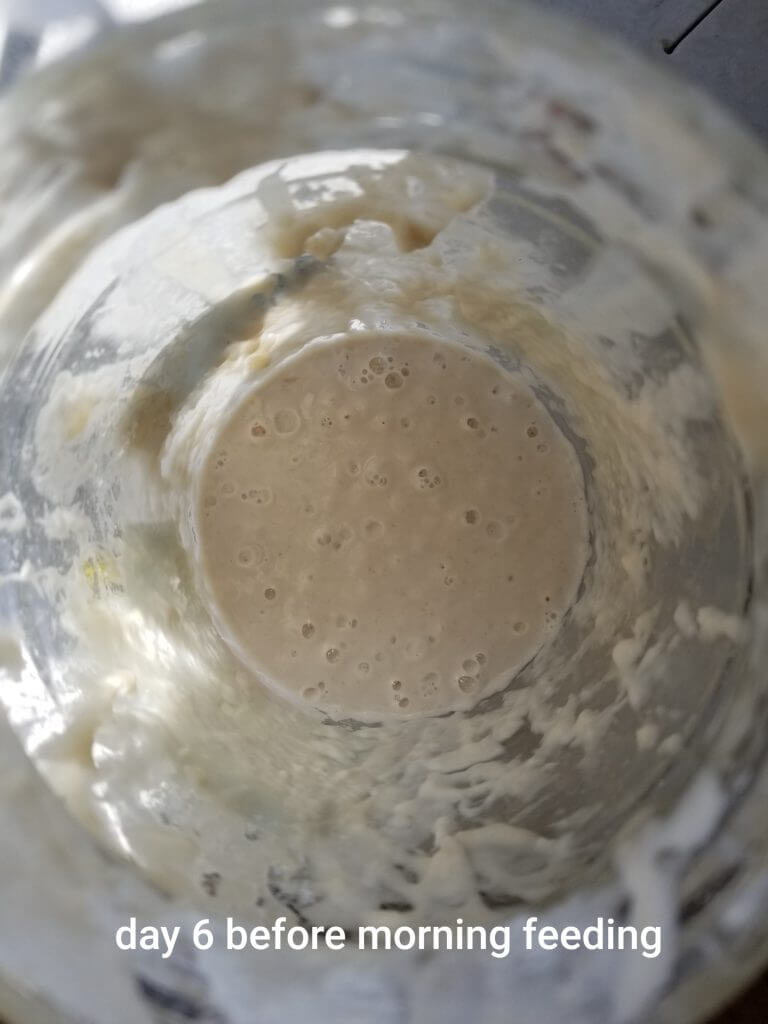
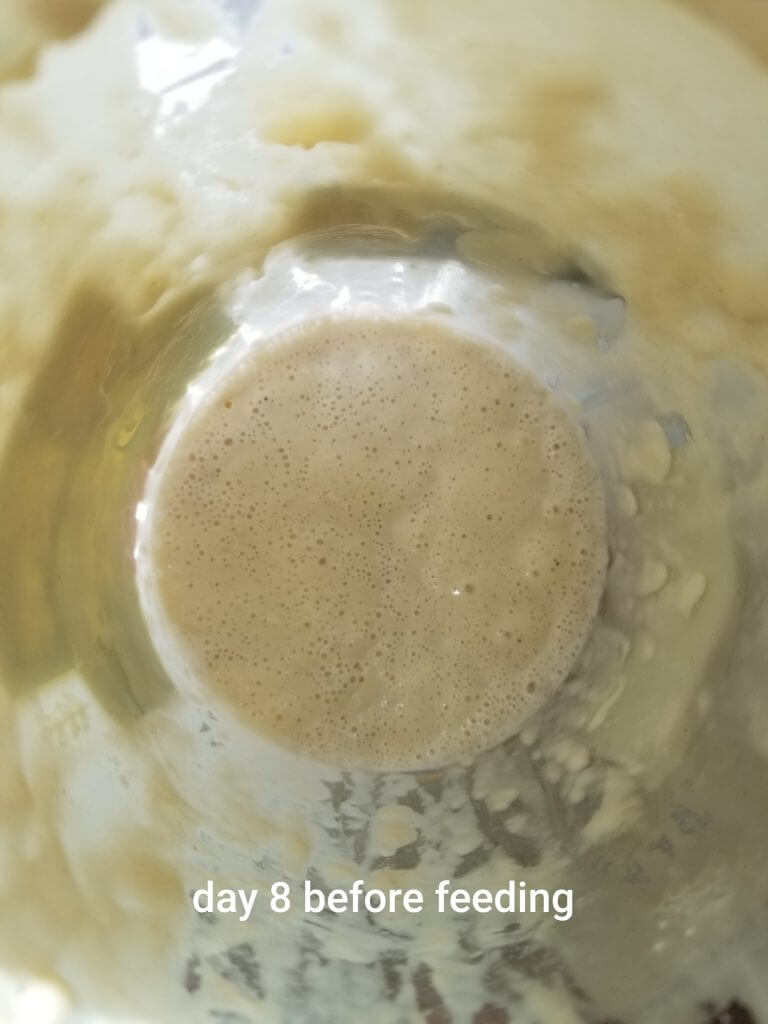
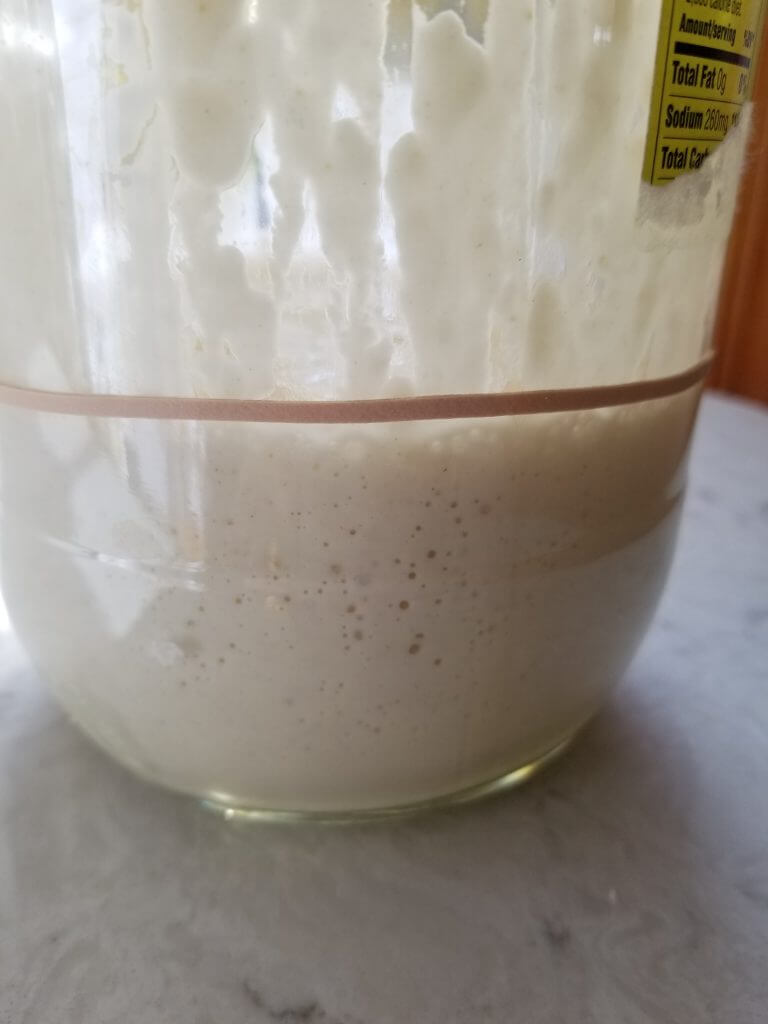
What to do with sourdough discard? Don't want to waste all that high quality flour from growing your sourdough? Me either!
Try these easy sourdough discard recipes:
- Easy Sourdough Discard Lemon Poppy Seed Bread
- Vegan Banana Bread with Sourdough Discard
- Sourdough Discard Banana Walnut Muffins
- Healthy Blueberry Muffins with Sourdough Discard
HOW CAN I TELL IF MY SOURDOUGH IS READY TO STORE IN THE FRIDGE?
If your sourdough starter is ready, the rubber band will be in the MIDDLE of the dough.
Meaning, the volume doubled after you fed it.
It will should double in size within TWO HOURS when it is ready.
When it is ready, discard half of it 1 more time.
- Add the other half to a clean jar.
- Feed it 1 more time with the 1 cup flour and ½ cup water.
- Cover it with a sealable lid.
- Let it stand at room temperature for 2 hours to get it activated.
- After it doubles in size, store it in the fridge!
What to do with your sourdough now? Try these overnight sourdough recipes:
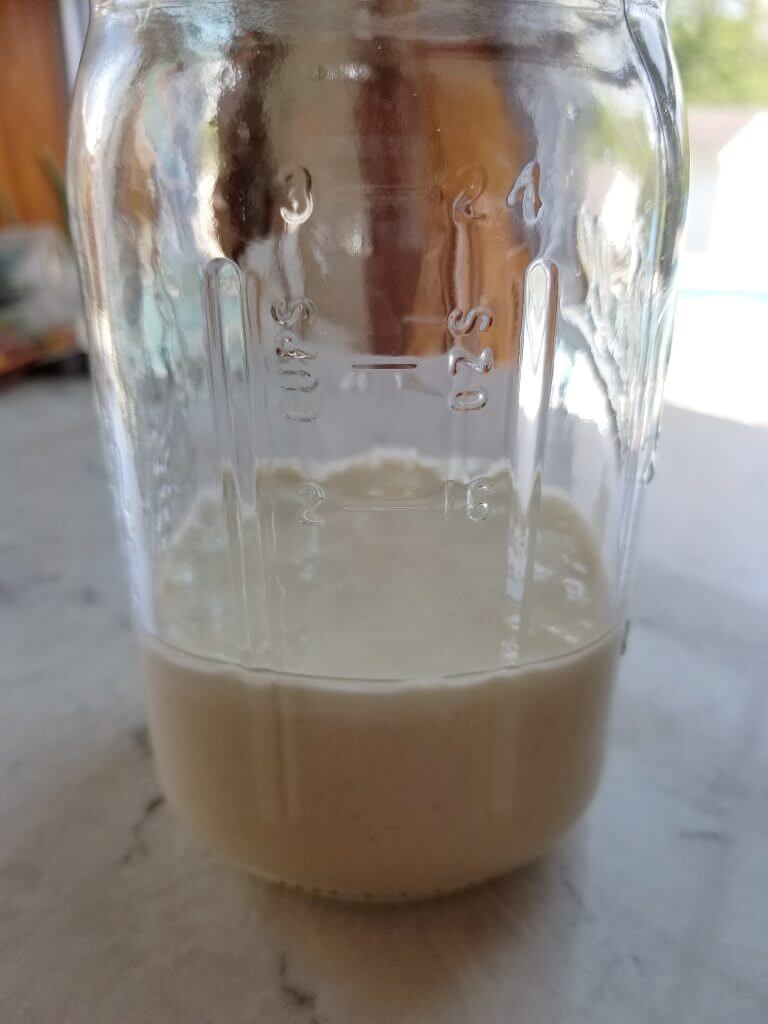
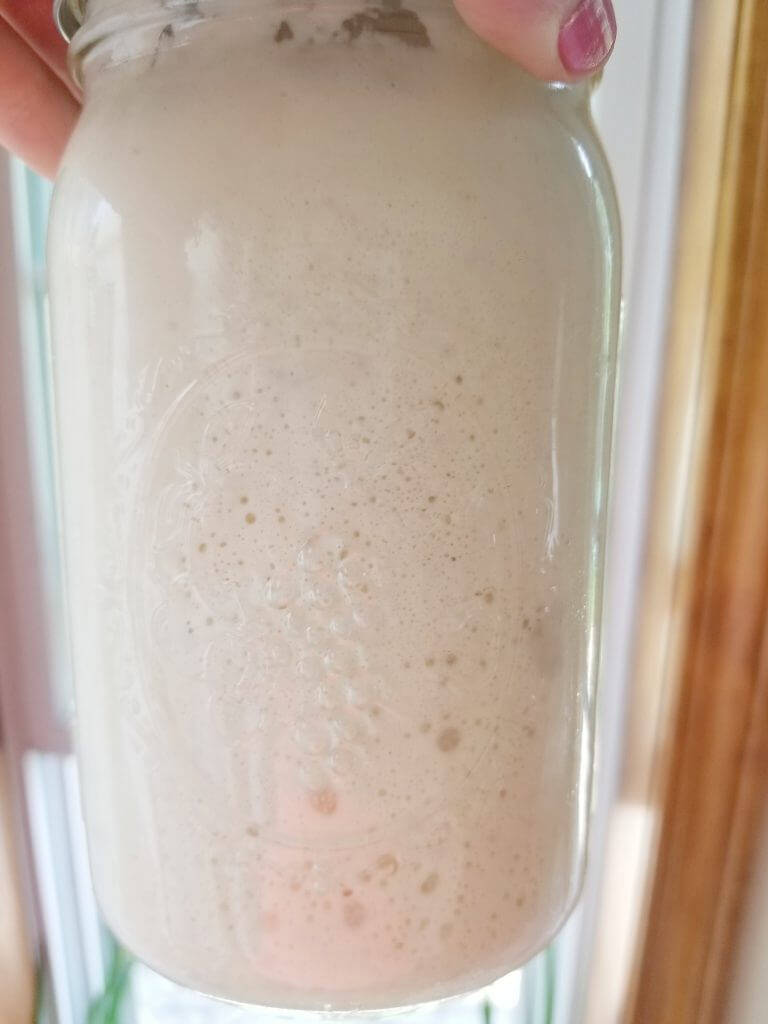
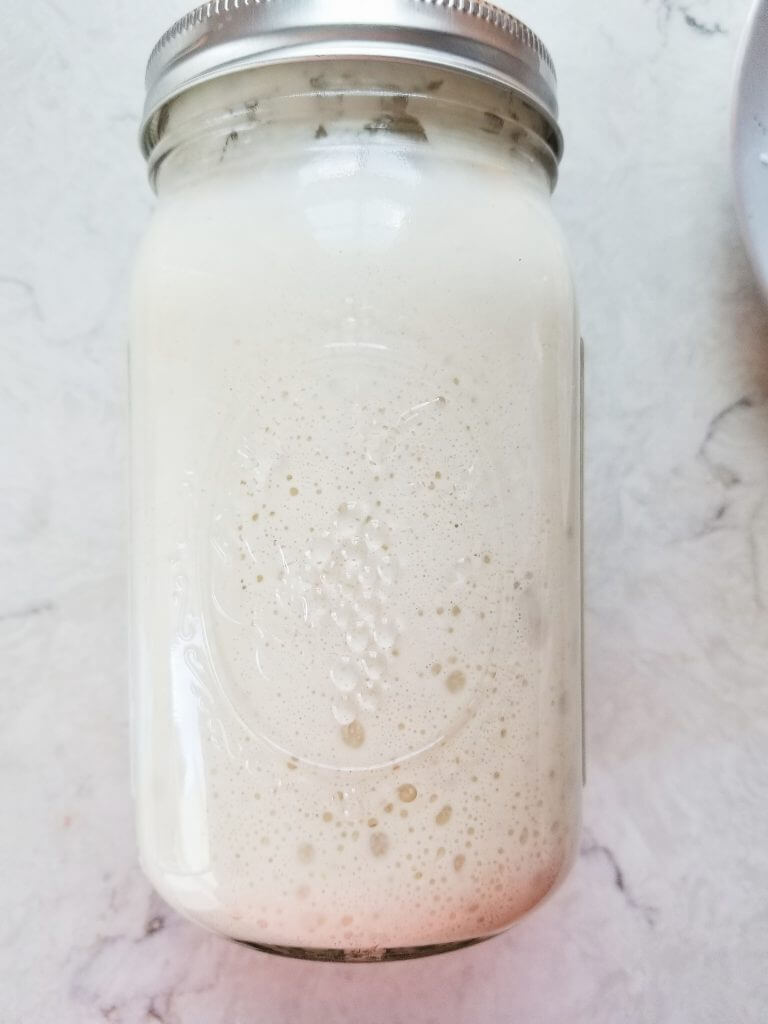
DO YOU WANT TO GROW A SOURDOUGH STARTER IN 1 WEEK INSTEAD?
Instead of morning feedings every 24 hours, simply increase your feedings to every 12 hours. So for example, you would feed your sourdough starter at 8 am and 8 pm every day for 7 days. The same as above:
- Discard half of the sourdough starter in the jar
- Add 1 cup UNBLEACHED all-purpose flour
- Add ½ cup room temperature water
- Stir COMPLETELY
- Cover with the cheesecloth
- Store somewhere warm where it gets airflow
WEEKLY MAINTENANCE OF YOUR SOURDOUGH STARTER.
You can feed your sourdough starter from the fridge as little as once a week, or as often as you use some of it in a recipe!
Okay so now you have your sourdough safely stored in the fridge. But don't forget about it! You will need to give it weekly feedings. Or, feed it after every time you use some for a recipe!
The sourdough maintenance feeding is the same as it was when you are growing it:
- Discard half (either as a discard, or to be used in your sourdough recipes)
- Add 1 cup unbleached all purpose flour to the jar
- Add ½ cup room temperature water to the jar
- Stir it in, cover it, and let it stand at room temperature 2 hours to get it going.
- Store in the fridge and repeat!


If you try my Sourdough Starter Recipe, please let me know your thoughts by leaving a rating and comment below! Ready for more? Subscribe to my newsletter or follow along on Pinterest, Instagram, Facebook, and Youtube!
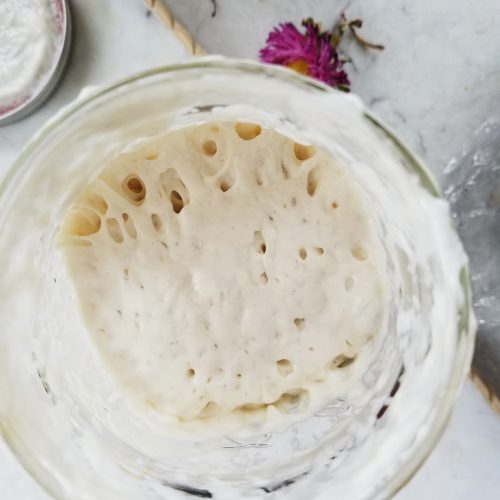
How to Make a Sourdough Starter without Yeast!
Equipment
- large mason jar
- cheesecloth
Ingredients
To begin:
- 1 cup whole wheat flour
- ½ cup room temperature water
To feed (~14 days):
- 11-13 cups UNBLEACHED all-purpose flour
- 5.5-6.5 cups room temperature water
For weekly feedings or after each time you use it:
- 1 cup UNBLEACHED all-purpose flour
- ½ cup room temperature water
Instructions
To get started:
- In a large mason jar, mix 1 cup of whole wheat flour with ½ cup room temperature water. Make sure there are no dry bits of flour left over. It should be a uniform mass. Scrape it into a rough ball (rather than having it stuck to the sides). Cover it with a cheesecloth (a paper towel works too) and secure it with a rubber band.
- Store your sourdough starter somewhere that it is out of direct light, warm, and will get proper airflow. Remember COLD=MOLD. I usually store mine next to the stove where it will get quite warm, on top of or inside my oven. Sourdough needs warmth to grow. It is ideal for it to be ~70-80 degrees.
To feed (every 12 hours or 24 hours):
- For twice a day 12 hour feedings, your sourdough will be ready in 7 days. For once a day 24 hour hour feedings, your sourdough will be ready in 14 days.
- Every morning, discard half of your sourdough starter. (Or, for twice a day feedings every morning then 12 hours later every evening)Add 1 cup of UNBLEACHED all-purpose flour (the bleach can kill those good sourdough bacteria) and ½ cup room temperature water. Stir very well to combine. Scrape down the sides. Cover with a cheesecloth or breathable cloth. Secure towel with a rubber band.
- Place your starter back in your warm spot. I love to keep mine in the oven with the oven light on. The warmth from the bulb creates a perfect warm spot in my house.If your house cools down at night, you can help insulate it and keep it warm by wrapping it with a towel.
- After week 1 (or when you see a lot of bubbles shortly after feeding your sourdough), add a rubber band to mark how high the sourdough rises overnight. Place the rubber band in line with the level of the dough after you feed it. HOW TO TELL ITS READY: The sourdough starter will rise to be double its size ~2 hours after feeding. So, the rubber band would be in the middle when you check it a few hours later.
Weekly feedings/as needed:
- Transfer your sourdough starter to a clean mason jar with a lid. Discard half of it 1 more time. Feed it with 1 cup flour and ½ cup water the same as before. Secure a lid on top this time rather than a cloth.
- Let it sit at room temperature 2 hours. You will see that the volume doubled in size and it is very bubbly. Store it in the fridge. Your sourdough can now be used as little as once a week, or as often as you need it! Use your sourdough starter in all your favorite sourdough recipes.Make sure to take your sourdough starter out of the fridge and feed it at least once a week, or give it a feeding after you take from it for your recipes!


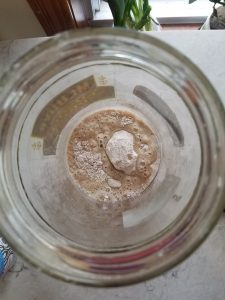
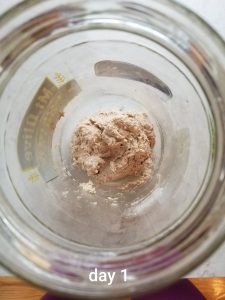
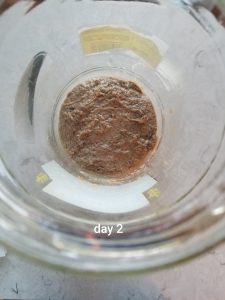
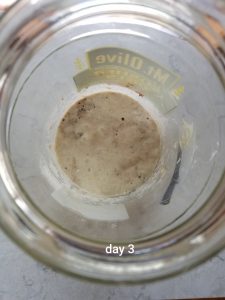

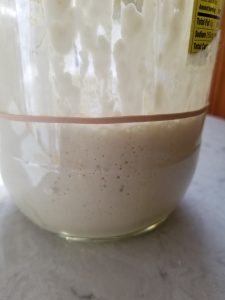
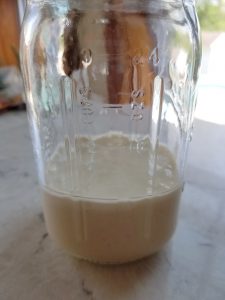
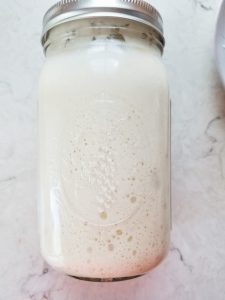

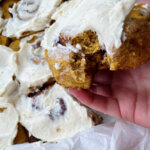


Anna
It's like you've read my mind!
I see so many people making sourdough these days and really want to jump on that train!
Thanks for sharing 🙂
Rebecca
Thanks for this great tutorial. This takes out all the guesswork.
[email protected]
Thanks Anna! I hope you try this one! I really wanted to come up with one that you didn't need to fuss with weighing the ingredients out
[email protected]
I'm glad you found it helpful! It definitely works faster when it is summer time 🙂
Jean
Is there any way to use the half that use discard every day. Seems quite wasteful to me. No offense meant as I really appreciate the post and I am absolutely going to get started. I just dint like to be wasteful.
Rosemary
I know, me either!! You can definitely use the discard every day! I love to bake mine into muffins, quick breads, pancakes, brownies, and one of my friends even used theirs for crackers! You could even put the discard in another jar feed it and give it to a friend who wants to start one too 🙂
Pam Gray
Now I have a beautiful healthy starter…Now what? How much flour? Bake time? I’m lost 🤷♀️
Rosemary
Yay I'm so glad it's so beautiful and healthy! Now you can store it in your fridge for once a week feedings (read this section "HOW CAN I TELL IF MY SOURDOUGH IS READY TO STORE IN THE FRIDGE?"), or whenever you take from it to bake! You can use part of it in my sourdough cinnamon rolls, or any sourdough recipe on line! Hope this helps <3
Christy Asay
Great job!!!
Do you have the recipe for Lemon, poppyseed bread using sourdough discard?
Thank you
Rosemary
Yes! Here's the link https://thehintofrosemary.com/dairy-free-lemon-poppy-seed-bread-recipe/
enjoy!